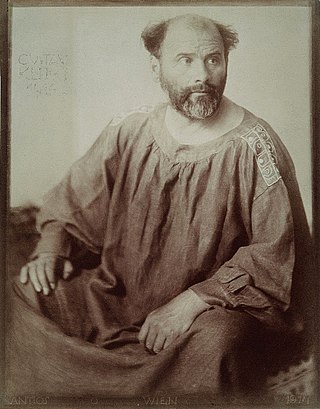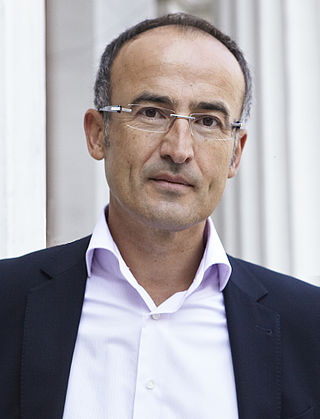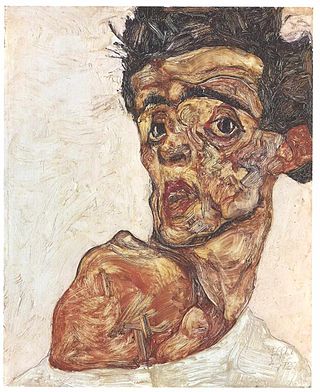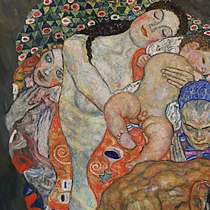
Gustav Klimt was an Austrian symbolist painter and one of the most prominent members of the Vienna Secession movement. Klimt is noted for his paintings, murals, sketches, and other objets d'art. Klimt's primary subject was the female body, and his works are marked by a frank eroticism. Amongst his figurative works, which include allegories and portraits, he painted landscapes. Among the artists of the Vienna Secession, Klimt was the most influenced by Japanese art and its methods.

Egon Leo Adolf Ludwig Schiele was an Austrian Expressionist painter. His work is noted for its intensity and its raw sexuality, and for the many self-portraits the artist produced, including nude self-portraits. The twisted body shapes and the expressive line that characterize Schiele's paintings and drawings mark the artist as an early exponent of Expressionism. Gustav Klimt, a figurative painter of the early 20th century, was a mentor to Schiele.

The Neue Galerie New York is a museum of early twentieth-century German and Austrian art and design located in the William Starr Miller House at 86th Street and Fifth Avenue in New York City. Established in 2001, it is one of the most recent additions to New York City's famed Museum Mile, which runs from 83rd to 105th streets on Fifth Avenue in the Upper East Side of Manhattan.

The Vienna Secession is an art movement, closely related to Art Nouveau, that was formed in 1897 by a group of Austrian painters, graphic artists, sculptors and architects, including Josef Hoffman, Koloman Moser, Otto Wagner and Gustav Klimt. They resigned from the Association of Austrian Artists in protest against its support for more traditional artistic styles. Their most influential architectural work was the Secession exhibitions hall designed by Joseph Maria Olbrich as a venue for expositions of the group. Their official magazine was called Ver Sacrum, which published highly stylised and influential works of graphic art. In 1905 the group itself split, when some of the most prominent members, including Klimt, Wagner, and Hoffmann, resigned in a dispute over priorities, but it continued to function, and still functions today, from its headquarters in the Secession Building. In its current form, the Secession exhibition gallery is independently led and managed by artists.

The Leopold Museum, housed in the Museumsquartier in Vienna, Austria, is home to one of the largest collections of modern Austrian art, featuring artists such as Egon Schiele, Gustav Klimt, Oskar Kokoschka, and Richard Gerstl.

The Kiss is an oil-on-canvas painting with added gold leaf, silver and platinum by the Austrian Symbolist painter Gustav Klimt. It was painted at some point in 1907 and 1908, during the height of what scholars call his "Golden Period". It was exhibited in 1908 under the title Liebespaar as stated in the catalogue of the exhibition. The painting depicts a couple embracing each other, their bodies entwined in elaborate robes decorated in a style influenced by the contemporary Art Nouveau style and the organic forms of the earlier Arts and Crafts movement.

Portrait of Adele Bloch-Bauer I is an oil painting on canvas, with gold leaf, by Gustav Klimt, completed between 1903 and 1907. The portrait was commissioned by the sitter's husband, Ferdinand Bloch-Bauer, a Viennese and Jewish banker and sugar producer. The painting was stolen by the Nazis in 1941 and displayed at the Österreichische Galerie Belvedere. The portrait is the final and most fully representative work of Klimt's golden phase. It was the first of two depictions of Adele by Klimt—the second was completed in 1912; these were two of several works by the artist that the family owned.

The Klimt University of Vienna Ceiling Paintings, also known as the Faculty Paintings, were a series of paintings made by Gustav Klimt for the ceiling of the University of Vienna's Great Hall between the years of 1900–1907. In 1894, Klimt was commissioned to paint the ceiling. Upon presenting his paintings, Philosophy, Medicine and Jurisprudence, Klimt came under attack for 'pornography' and 'perverted excess' in the paintings. None of the paintings would go on display in the university.

The Beethoven Frieze is a painting by Gustav Klimt on display in the Secession Building, Vienna, Austria.

Tobias G. Natter is an Austrian art historian and internationally renowned art expert with a particular expertise in "Vienna 1900".

The Tree of Life, Stoclet Frieze is a painting by the Austrian symbolist painter Gustav Klimt. It was completed in 1909 and is based on the Art Nouveau (Modern) style in a symbolic painting genre. The dimensions of the painting are 195 by 102 centimetres, and it is housed at the Museum of Applied Arts, Vienna, Austria.

Facing the Modern: The Portrait in Vienna 1900 was an exhibition at the National Gallery, London, running from 9 October 2013 through to 12 January 2014.

Johann Victor Krämer was an Austrian painter and photographer, working generally within the Orientalist genre. He was a founding member of the Vienna Secession, and received many awards through his life.
Hope I is an oil painting created by Gustav Klimt in 1903. It is 189 cm x 67 cm and currently located in the National Gallery of Canada, Ottawa. The main subject of this work is a pregnant, nude female. She is holding her hands together above her stomach and close to her chest. She gazes directly at the viewer and has a great mass of hair with a crown of forget-me-not flowers placed on her head. The scene is beautiful upon first glance but once the viewer's eyes move to the background, deathlike figures become noticeably present.

Leopold Forstner was an artist who was part of the Viennese Secession movement, working in the Jugendstil style, focusing particularly on the mosaic as a form.
Gustav Nebehay was an Austrian art dealer and patron of the arts.

Walburga "Wally" Neuzil was an Austrian nurse who was the lover and muse of the artist Egon Schiele between 1911 and 1915.

Seated Woman with Bent Knees is a 1917 painting in gouache, watercolor, and black crayon on paper by the Austrian Expressionist artist Egon Schiele.

Lady with a Fan was the final portrait created by Gustav Klimt. Painted in 1917, the uncommissioned piece depicting an unidentified woman was on an easel in his studio when he died in 1918. Like many of Klimt's late works, it incorporates strong Asian influences including many Chinese motifs.

Women Friends (1916-1917) is a painting by Austrian symbolist painter Gustav Klimt. Alternatively known as The Friends, or Girlfriends II, among others, the work was destroyed by fire in 1945 alongside several other of Klimt's paintings in the burning of Schloss Immendorf.




















